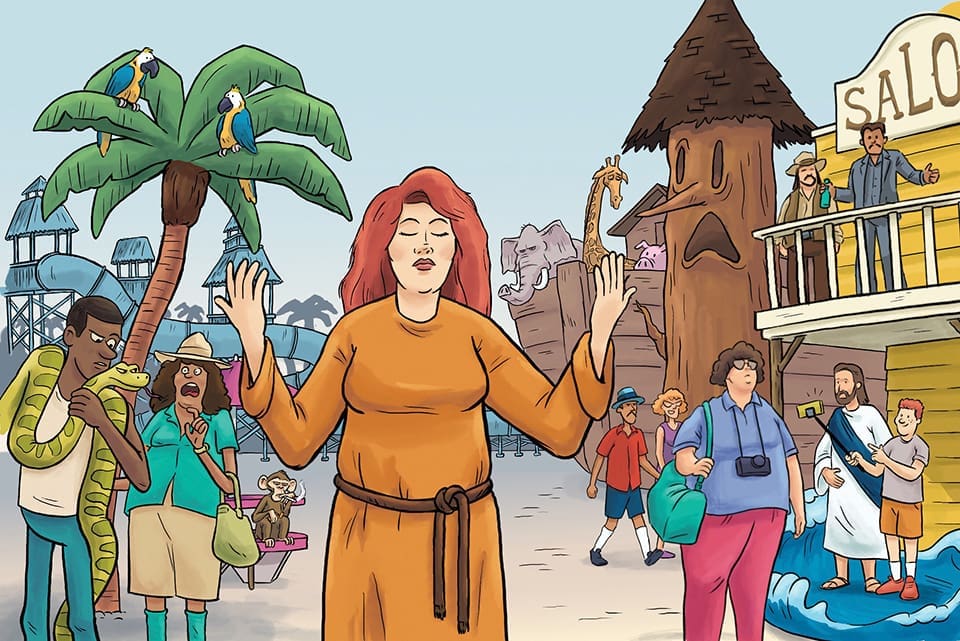by | November 24, 2016
Diane Roberts on the Law of Attractions
Take a holy rolling ride through Florida’s wacky theme parks of yesteryear and today.

You had to pay a quarter, and the lady at the cash register had to light the cigarette, but the monkey would smoke it with a look of deep melancholy on his little face. Nasty, unhealthy habit, of course, but you’d smoke, too, if you were doing hard time in a low-rent roadside attraction attached to a Gulf service station about 18 miles south of Perry, Florida.
The place was called Florida Reptile Land, not that it was particularly focused on reptiles. Sure, there were snakes of various flavors, a sleepy iguana, an alligator in an oily little slough out back; a dancing chicken, a possum who’d hiss at you and a giraffe in a wire pen out front by the gas pumps also occupied the park. The giraffe mostly kept his (or her) head up in the pecan trees, chewing. When I was seven or eight years old, I was obsessed with the giraffe: did she (or he) long for the savannas of Africa? I didn’t know what a savanna was, but National Geographic said that’s where giraffes were supposed to live. I was obsessed with Reptile Land: in those pre-interstate days, US 19-98 went right by the place, so every time we drove to Miami to stay with our cousins I’d beg to stop. You could get cold Cokes in bottles and sugary divinity thick with pecans and bags of orange-flavored gum balls there. The “zoo” was free. There was a box for donations to “Feed the Animals,” and my mother would always put several dollars in there, causing my father to complain that the owners would just keep the money and not feed the animals and she was wasting her money, as usual. The animals did look hungry, even the monkey, the star, brandishing his Marlboro.

I heard later—in the mid-1980s, I think—that some guys in Tallahassee hatched a plot to liberate the cigarette-smoking monkey. He was, after all, a fellow primate, practically kinfolk. They took some wire cutters and a bunch of bananas. But when they got to Reptile Land, it was closed, out of business, and all the animals gone.
You’d have thought that Florida’s flora and fauna were dramatic enough, with lapis lazuli seas, giant turtles, glorious springs, and cypress trees tall as a cathedral spire, yet the people who moved to the Sunshine State could not help but want to fancy it up a bit. Florida had manatees and alligators, why not add some lions? And a giraffe? And parrots? Why not build hotels that look like the Alhambra or Versailles, towns that look like Seville, and golf courses where the grass is tricked into thinking it lives in Scotland? At Cypress Gardens, an idyllic spot near Winter Haven, real estate entrepreneurs Dick and Julie Pope didn’t content themselves with a simple flowers and trees: In the mid-1930s and 1940s they built a Florida-shaped swimming pool and a fake plantation house. They added girls in hoopskirts and girls on waterskis turning high-speed somersaults on Lake Eloise. There’s something about Florida that inspires fantasy and excess.
From the 1920s onward, Florida heaved with improvised, low-rent, magnificently weird tourist lures parked by the side of the highway, conveniently spaced so that, just when the kids in the back seat were about to throw up or stage mutiny, parents could stop and divert them at Dinosaur Wildlife in Spring Hill, with its pink quasi-brontosaurus statue and taxidermied two-headed rattlesnake; or Six Gun Territory near Silver Springs, a fake “Western” town with shoot-outs almost hourly; or the Tom Gaskins’ Cypress Knee Museum, which beckoned you off 27 South with signs hollering: “Come See Tom’s Knees” and “hey lady if he won’t stop hit him on head with shoe.”
These treasures are all lost, along with the Moonshine Still exhibit, the Honey Bee Observatory, Rattlesnake Headquarters (where you could buy canned rattler meat in “Supreme Sauce”), the Waltzing Waters Aquarama, Petticoat Junction Amusement Park, Clyde Beatty’s Jungleland and the beloved Atomic Tunnel, home of “Happy the Walking Fish,”—all returned to kudzu jungle or palmetto scrub, paved over, or turned into an outlet mall. Before the interstates, before the advent of what Carl Hiaasen calls “Team Rodent,” tourists on the South Dixie Highway or Route 19 along the Gulf Coast would jam on the brakes when they saw a sign that said “Coral Castle” or “Live Mermaids.” How could you not stop? Edward Leedskalnin, a Latvian immigrant, took decades to singlehandedly carve an intricate building out of coral rock, supposedly in tribute to his lost love back in the old country. As for the mermaids, Weeki Wachee presented strong-lunged young women in zip-up lamé tails and sequinned brassieres drinking Coca-Colas and performing underwater adagios 16–20 feet beneath the surface of the spring.
Of course, when the Mouse colonized Central Florida with his princesses and talking dogs, a fountain lit by Christmas lights or an orchid shop pretending to be a nuclear fallout shelter didn’t entice the way it once did. Even the sirens of Weeki Wachee struggled to compete with a CGI Ariel you can visit in her sea kingdom without getting a drop of water on you. And how magical can Goofy Golf (the name doesn’t refer to Disney’s Goofy but the aesthetics of the place) on Panama City Beach be compared to flying around Hogwarts on the Flight of the Hippogriff ride at Universal Studios?
Florida as Florida ceased to be the point; the theme parks themselves became the destination. You can choose the world you want to lose yourself in: Hogsmeade, a Daffy Duck cartoon, The Simpsons’ Springfield, Queen Elsa’s Ice Palace, or, if your pilgrimage might be spiritual, first-century Jerusalem, conveniently located 15 miles from Orlando International Airport and rendered exactly as Jesus would have known it (except for the air-conditioning).

I speak, obviously, of The Holy Land Experience, located just off Interstate 4 exit 78—not to be confused with Holy Land USA of Bedford, Virginia, which has been closed since 2009, the replica of Noah’s Ark now converted into a nine-bedroom house; or Holy Land USA in Waterbury, Connecticut, abandoned and rapidly becoming a picturesque ruin; or Holey Land in Palm Beach County where the python hunting is particularly good. According to its official history, Central Florida’s Holy Land Experience “was born in the heart of a Jewish believer named Marvin Rosenthal,” who felt called to build a Christian theme park. In 2007, Rosenthal’s organization sold the park to Trinity Broadcasting Network, an outfit founded by evangelists Jim and Tammy Faye Bakker and Paul and Jan Crouch, who made it even bigger and better and more Jesus-y. For the price of a $50 day pass, you can visit The Wilderness Tabernacle and see “Aaron, the High Priest” prepare the sacrifices right there next to the shiny Ark of the Covenant. You can walk into the belly of Jonah’s whale, feast on a Samson Foot-Long Dog or Elijah Flatbread Pizza at Esther’s Banquet Hall, and buy sanctified souvenirs at the Jerusalem Market. Jesus gets crucified pretty much every afternoon, too, and you can watch.
Like many of Florida’s other monuments to unreality (the ones outside Universal and Disney, anyway), The Holy Land Experience has fallen on some hard times. TBN stopped being its sugar daddy and Jan Crouch, the pink-wigged Pentecostal diva who oversaw day-to-day operations, died this past June at the age of 78. Crouch, said to be the “soul” of the park, famously claimed to have raised her pet chicken from the dead after it got hit by a car. She also swore her long struggle with depression was healed by a dream in which she saw Jesus laughing uncontrollably. But when she went to meet her maker, she left a trail of scandal and debt: The Orlando Sentinel reported that The Holy Land Experience “has seen years of ongoing litigation with the Crouches’ granddaughter, Brittany Davidson (formerly Koper), over allegations of embezzlement and spending charitable donations on extravagant lifestyles.” To raise a bit of cash, the theme park recently held an estate yard sale, offloading such righteous junk as a gilt camel with a jeweled crown, a white Harley-Davidson festooned with angel wings, a number of throne-like chairs, Roman Centurion outfits and a large fake snake.
How will Florida’s Eden cope without its serpent? Maybe the plan is to upgrade and get an animatronic Tempter to slither through the concrete and plastic. Many of our last masterpieces of tackiness are struggling: Cypress Gardens, once the flowery wonder of the world, is now a Legoland. Goofy Golf, with that kitschy collection of statues rarely seen on normal greens—giant monkeys, turtles, dinosaurs, alligators, fish and a Sphinx painted a febrile, Trumpian shade of orange—was looking a trifle shabby last time I saw it. I pray it will continue to confound good taste on Panama City Beach. At least the mermaids of Weeki Wachee will swim eternally in their sky-blue spring, hair floating, tails fluttering: The state of Florida took over the park in 2008, ensuring a steady flow of revenue.
I can think of no better use of our tax dollars than to support the lovely naiads of Hernando County.
As for The Holy Land Experience, I’m not sure Jesus would dig that show. Your tax dollars don’t pay for The Holy Land Experience, but the attraction does get a break from the state—it’s tax exempt. Thanks to a law passed by the state legislature in 2006, any place with a “biblical history display” can charge admission and make a profit, but needn’t render unto the government one red cent—or in this case, $2.2 million, the Orange County’s estimate of what the Crouches’ do-it-yourself Judea would otherwise owe. Jan Crouch, the pearl-draped patron saint of The Holy Land Experience, was paid more than $400,000 a year in salary, along with $300,000 of meal expenses a year. She bought Conway Twitty’s grand estate in Tennessee and his-and-her mansions in a gated community in California and, according to her granddaughter Brittany, rented two adjacent rooms in a deluxe hotel in Orlando for close to two years for her and her Maltese dogs, as well as an air-conditioned motorhome for her two pampered pooches. The Ministry tried to claim two Lake Windermere homes as a “parsonage” and thus also tax-exempt, but the state didn’t buy it.
This is the prosperity gospel at work, y’all. But isn’t there something in the Bible about Jesus kicking the money changers and deposit takers out of the Temple? Ah well, this is Florida. As the old tourist board slogan used to say, “Florida. The Rules are Different Here.”
READ MORE FROM FLAMINGO COLUMNIST DIANE ROBERTS.
About the Author
Diane is an eighth-generation Floridian, educated at Florida State University and Oxford University. Her work has appeared in The New York Times, The Guardian and the Tampa Bay Times. She has also authored four books, including “Dream State,” a historical memoir of Florida.





